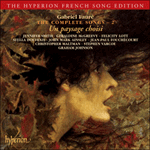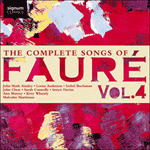This is not a mélodie but rather a
cantique. It was commissioned for a volume of
Contes mystiques, poems by Stéphan Bordèse set to music by various composers, and published by Durand in 1890. Among those who contributed to the collection were Holmès, Lecocq, Massenet, Paladilhe, Saint-Saëns, Viardot and Widor.
En prière was included in the Hamelle three-volume edition and countless singers and pianists have come to know, and perform, this song as if it were a bona-fide mélodie. One may think its seraphic mood may be problematic to those who do not whole-heartedly admire Fauré’s
Requiem, more or less a contemporary work. On the other hand, like the religious songs of Schubert, this music never cloys; Gounod or César Franck identify with their texts in a more personal way which make a different impression. Fauré has learned much from Gounod, particularly in a setting like this; but as in
Clair de lune he keeps his distance as if avoiding avowals made in the first person. This is a portrait of devotion, a picture of someone at prayer, rather than the composer at prayer himself. The creation of an atmosphere of heartfelt piety seems effortless, the progression of harmonies a miracle of fluidity. Only Fauré could have written this music. At ‘Révélez-Vous à moi’ the triplet accompaniment cedes to a motif of crotchets which wafts across the stave as if the Holy Spirit revealed; on the song’s last page this alternates in an almost liturgical manner with triplets, and is repeated no fewer than five times, as if in benediction.
from notes by Graham Johnson © 2005
Cette pièce tient plus du cantique que de la mélodie. Elle fut commandée pour un volume de
Contes mystiques édité par Durand en 1890, un ensemble de poèmes de Stéphan Bordèse mis en musique par des compositeurs comme Holmès, Lecocq, Massenet, Paladhile, Saint-Saëns, Viardot et Widor.
En prière fut intégrée à l’édition en trois volumes de Hamelle et maints chanteurs, maints pianistes en vinrent à l’envisager, à l’interpréter comme une authentique mélodie. Son séraphisme pourrait gêner qui n’admire pas de tout son cœur le
Requiem de Fauré, peu ou prou contemporain. D’un autre côté, comme les lieder religieux de Schubert, cette musique n’écœure jamais; Gounod ou César Franck s’identifient à leurs textes d’une manière plus personnelle, qui laisse une impression différente. Fauré a beaucoup appris de Gounod, surtout dans ce genre de mise en musique; pourtant, de même que dans
Clair de lune, il garde ses distances, comme pour éviter les aveux à la première personne. C’est le portrait d’une dévotion, la représentation de quelqu’un, plutôt que du compositeur lui-même, en prière. La création d’une atmosphère de piété venue du cœur semble aisée, la progression des harmonies un miracle de fluidité. Seul Fauré a pu écrire cette musique. À «Révélez-Vous à moi», l’accompagnement en triolets abdique devant un motif de noires qui flotte de part et d’autre de la portée, comme si l’Esprit saint se révélait; à la dernière page de la mélodie, ce motif alterne de manière quasi liturgique avec des triolets et est répété pas moins de cinq fois, comme en une bénédiction.
extrait des notes rédigées par Graham Johnson © 2005
Français: Hypérion


 Fauré: The Complete Songs, Vol. 2 - Un paysage choisi
Fauré: The Complete Songs, Vol. 2 - Un paysage choisi Fauré: The Complete Songs, Vol. 4
Fauré: The Complete Songs, Vol. 4
